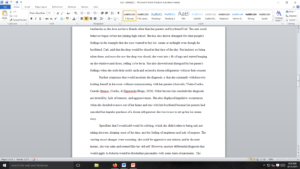Treating anxiety disorders
In this assessment I’ll be asking you to apply what you’ve learned to several brief case studies. I’d like you to identify the most likely diagnosis for each case, along with a rationale to support your position.
Open the attached file named casestudy1.pdf. The file will open in a new tab.
For each of the following cases, answer these questions:
What is the most probable diagnosis?
Why? Which symptoms of this disorder are present? Which are absent?
What further information would help you ascertain if this were the correct diagnosis? Name at least two, and how they would help.
Would you add any specifiers? If so, which would you choose and why?
Be sure sure to review the scoring rubric prior to submitting your assignment. Submit your Case Study 1 to the assignment folder no later than Sunday 11:59PM EST/EDT. (This folder may be linked to Turnitin.) APA formart
bellow I attach the case study https://saintleo.brightspace.
Part 2 :Discussion Board
Discussion Topic
We know from research that a variety of behavioral techniques, including exposure, are very effective in treating anxiety disorders. However, the prospect of being exposed to the object or situation that causes anxiety can itself be a very frightening one for those seeking help. This can create a conundrum for those who want to treat their anxiety, and can sometimes be a barrier that prevents them from getting better. Reflect on this for a moment, and share your thoughts on how you would approach this conundrum if you were a clinician. What would you say to the anxious client to remedy their concerns? Make sure to reference your textbook (Bridley & Daffin, 2020) and the module in support of your response.APA formart and 500 word
reading references book
module 6 https://opentext.wsu.edu/
module 7:https://opentext.wsu.edu/
Requirements: 1
Answer preview
The treatment of a person with an anxiety disorder can be a challenge to some patients when it comes to its treatment. Some patients can find it difficult to face their fear, hindering treatment. As a clinician, there are several strategies I would use depending on the type of anxiety and extremity level of the same. One of the methods I would use would be Rational -Emotive therapy. Rational –Emotive treatment, also known as Rational –Emotive Behavior Therapy (REBT), was introduced in the 1950s by Albert Ellis. The primary purpose of the therapy is to identify and isolate negative and irrational thoughts that would be a hindrance to the treatment process (Bridley & Daffin 2020). positive and rational thoughts providing reassurance and a sense of calm would replace the negative thoughts.
[1211 Words]

Treating anxiety disorders

